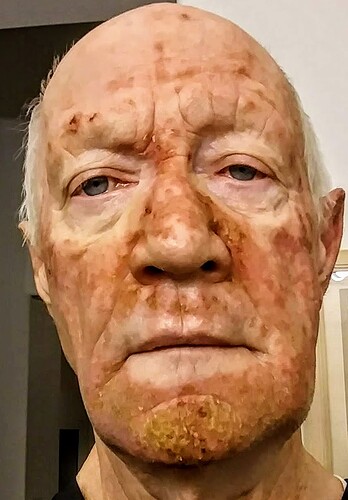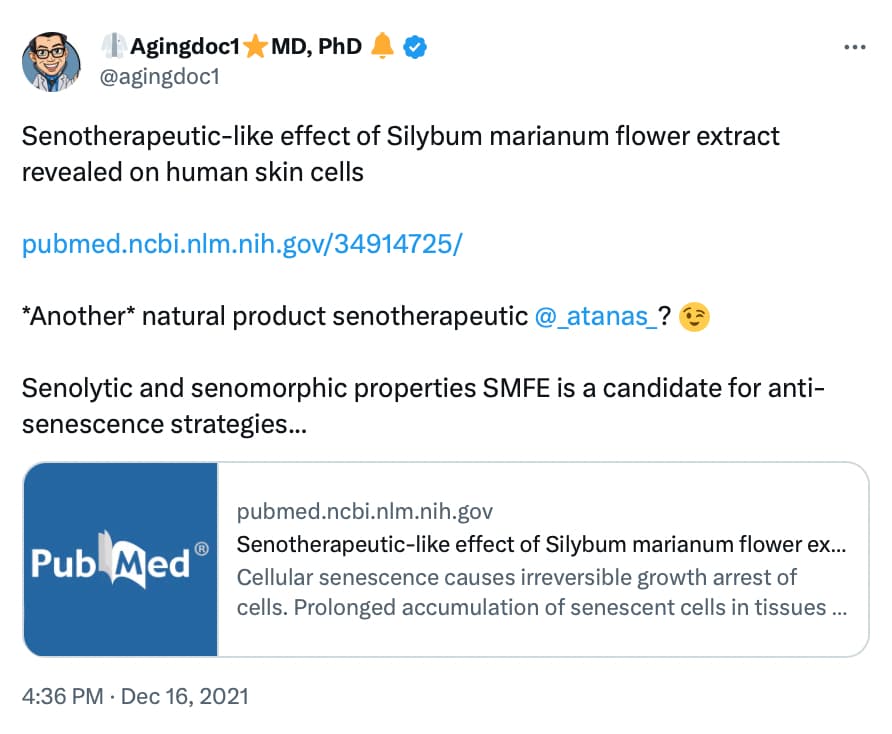Senolytics, such as dasatinib and fisetin, are drugs that selectively eliminate senescent cells and are already topically administered to the skin, showing potential antiaging effects.
We suggest that topical administration of senolytics/senotherapeutics could counteract the overall whole-body aging phenotype.
I find this area potentially very interesting. Given the seeming success of Oneskin’s senolytic peptide for topical use on skin,
it seems that more powerful senolytic drugs like dasatinib used in a topical formulation might be effective… similar to how people are making rapamycin skin creams. DIY Rapamycin skin cream that is based on this research: Topical rapamycin reduces markers of senescence and aging in human skin: an exploratory, prospective, randomized trial
some related research:
Overall, topical dasatinib induced regression of the cancer similar to topical 5-fluorouracil but with less inflammation and no ulcers. Dasatinib applied daily to mice induced 45 percent and 77 percent regression of cutaneous squamous cell carcinoma after two and five weeks of treatment, respectively, compared to controls. 5-fluorouracil induced 70 percent regression at two weeks in eight mice; however, it was associated with epidermal ulcers in two out of 15 of the tumors observed, and seven of the eight mice in that group died. No ulcers or deaths were observed in the dasatinib or control groups.
Inflammation was determined by counting CD3-positive T cells and neutrophils – immune cells that respond to inflammation – at the treatment site. Dasatinib did not increase levels of CD3-positive T cells or neutrophils, while 5-fluorouracil induced inflammation and was associated with higher numbers of CD3-positive T cells and neutrophils compared to dasatinib-treated mice, the researchers report.
In a second experiment, the researchers found that BEZ-235, known to inhibit the PI3K/mTOR pathway in cancer, acted similarly to dasatinib. The treatment induced regression of the cancer by over 60 percent compared to control lesions at five weeks without significant inflammation or ulcers.
Topical Targeted Therapies Show Promise in Treatment of Skin Cancer - Penn Medicine
Certainly interesting. I wonder what the best frequency of use of topical dasatinib would be for skin rejuvenation purposes…considering the warnings about overly frequent systemic use.
Good question. Most side effects of Desatinib are systemic so the question is how much systemic absorption occurs. I would doubt very much. As a senolytic, you wouldn’t be using it that often either.
I wasn’t thinking so much systemically, as I was the effect of daily vs weekly vs quarterly, semi-yearly, etc (over)effect on senescent cells in the skin. You need them for wound healing, for instance.
I had suffered chronic actinic keratoses for decades because of my extreme exposure to sunlight when I was young. We did not have the benefit of the high SPF suntan lotions that are now available.
Rapamycin taken internally has had a truly remarkable effect on my skin. Actinic keratoses are precursors to cancer and are cancerous in nature. I saw my dermatologist 3 to 4 times a year. I have not seen a dermatologist since I started taking rapamycin.
Here are the before and after photos. The first one is not as bad as it looks. It just is the way it looks after typical “Blue Light” therapy.

I am actually using One Skin on my face and body as is my daughter, someone on the forum mentioned they were participating in a study I believe. I had scaly patches by my brow/forehead which may be related to the Rapa, it disappeared in 2 days of use. My skin feels like a babies butt….so far, I’m really impressed and this is 10x better than Le Mer. My daughter has terrible eczema on her ankles, we shall see what it does for her. There’s something very positive with this product for me. It’s been two weeks but wow!
The One Skin OS1 product is a something they are calling a senolytic peptide. I heard in interviews with the founder that they went with peptides so they could avoid the long and expensive process of FDA approval that they’d incur if they went for a drug solution. But, it seems there are likely many drugs on the market that may already be available and that are senolytic compounds that are available but not yet used in skin creams (or are generic and therefore nobody will ever fund the trials to see if they work as skin creams).
Here is some more research I’ve come across regarding senolytics like dasatinib and skin aging. I have not yet found any research papers (that I can access) where they’ve tested the most tested senolytic drugs in any topical formulations… e.g. Dasatinib, Quercetin, Fisetin and Navitoclax. Seems like something that would not be very hard to try in a formulation. Ideally pre and post tested with something like the Visia skin scanner as I described here.
Background
Skin ageing is caused by numerous factors that result in structural and functional changes in cutaneous components. Research has shown that senescent cells are known to accumulate in skin ageing, however, the role of senescent cells in skin ageing has not been defined.
Objectives
To elucidate the role of the senescent cell in skin ageing, we evaluated the effect of known senolytic drugs on senescent dermal fibroblasts.
Conclusions
Taken together, our results indicate that selective clearance of senescent skin cells can attenuate and improve skin ageing phenotypes and that senolytic drugs may be of potential use as new therapeutic agents for treating ageing of the skin.
Attenuation of intrinsic ageing of the skin via elimination of senescent dermal fibroblasts with senolytic drugs
https://onlinelibrary.wiley.com/doi/abs/10.1111/jdv.18051
Advancements in therapeutic drugs targeting of senescence
https://journals.sagepub.com/doi/full/10.1177/2040622320964125
Its a good question. OneSkin suggests daily application of their senolytic peptide based cream… but I’m sure its much less potent than the senolytic drugs like dasatinib. But as far as what is optimal, its anyone’s guess. I think the best approach may be to test out different schedules on different hands, or areas of skin, photograph in the same light/distance every 2 months, and see if one schedule seems better in terms of results than the other, then continue to test.
We covered it in these two posts - but easy to miss. I probably need to pull it out to its own thread.
Here: Rapamycin for Hair Growth, Hair Pigmentation, Skin Anti-aging
and here: DIY Rapamycin skin cream
I agree, though speaking as one who has tried, it is devilishly hard to get valid serial photos without a bespoke set-up unless there is a large difference in effect.
Your link from FightAging! Includes this important quote related to topical Rapamycin and OneSkin.
Interestingly, the OneSkin folk used rapamycin as a positive control, and found it worsened aspects of their skin models even as it lowered markers of cellular senescence - so perhaps not something to dive into until more data has accumulated.
Looking at the meat of the data in this preprint, peptide 14 performs as well or better than topical rapamycin in reducing markers of cellular senescence, at least in skin models and in skin biopsies taken from older volunteers. Formal trials and resulting human data are pending - though the product is available for anyone who wants to give it a try. Given the existing data, it will be interesting to see how the product performs in older people in comparison to topical rapamycin use.
That is true. I’ve pointed that out here in this post, and I’ll repeat it here:
But there is also research that suggests rapamycin may not be that good for the skin, increasing inflammatory markers (which is not a good sign), and triggering a breakdown of the extracellular matrix:
"Rapamycin is a long studied molecule affecting mTOR/nutrient signaling and has recently been shown to decrease P16 levels of aging skin21, therefore it was chosen as a positive control of senotherapeutic effect in aging skin models. " … “Rapamycin induced a significant increase in P16 expression, a trend towards increased expression of inflammatory markers (IL6 and IL8), and a significant decrease in Keratin 1 gene expression levels (Fig. 3B). In the dermis, peptide 14 treatment promoted a significant reduction in B2M gene expression, a pro-aging factor, as well as in the expression ofIL8. Rapamycin treatment induced no significant changes in these markers and increased Matrix Metalloproteinase-1 (MMP1) gene expression, indicative of breakdown of the extracellular matrix (Fig. 3C).”
Source:
https://www.biorxiv.org/…/10.1101/2020.10.30.362822v2.full
Another compound that may be something we want to consider adding to a skin cream for anti-aging.
Glutaminase inhibitors rejuvenate human skin via clearance of senescent cells: a study using a mouse/human chimeric model
Skin aging caused by various endogenous and exogenous factors results in structural and functional changes to skin components. However, the role of senescent cells in skin aging has not been clarified. To elucidate the function of senescent cells in skin aging, we evaluated the effects of the glutaminase inhibitor BPTES (bis-2-(5-phenylacetamido-1, 3, 4-thiadiazol-2-yl)ethyl sulfide) on human senescent dermal fibroblasts and aged human skin.
BPTES selectively eliminated senescent dermal fibroblasts regardless of the method used to induce senescence; aged human skin grafts treated with BPTES exhibited increased collagen density, increased cell proliferation in the dermis, and decreased aging-related secretory phenotypes, such as matrix metalloprotease and interleukin. These effects were maintained in the grafts 1 month after termination of the treatment. In conclusion, selective removal of senescent dermal fibroblasts can improve the skin aging phenotype, indicating that BPTES may be an effective novel therapeutic agent for skin aging.
Consumer-oriented write-up on this:
Full Paper Here: Glutaminase inhibitors rejuvenate human skin via clearance of senescent cells: a study using a mouse/human chimeric model | Aging
More on the glutaminase inhibitor BPTES:
As of July 2018 some glutaminase inhibitors are in mid-stage clinical trials. In 2021, it was reported that a GLS1 inhibitor eliminated senescent cells from various organs and tissues in aged mice, ameliorating age-associated tissue dysfunction. Results suggest that senescent cells rely on glutaminolysis, and inhibition of glutaminase 1 may offer a promising strategy for inducing senolysis in vivo.
Sources:
Glutaminase Inhibitor II, BPTES
CAS 314045-39-1
Another related paper from March of this year:
Results
We found that ABT-263 and ABT-737 induced selective clearance of senescent dermal fibroblasts, regardless of the method of senescence induction. Aged mouse skin treated with ABT-263 or ABT-737 showed increased collagen density, epidermal thickness, and proliferation of keratinocytes, as well as decreased senescence-associated secretory phenotypes, such as MMP-1 and IL-6.
Conclusions
Taken together, our results indicate that selective clearance of senescent skin cells can attenuate and improve skin ageing phenotypes and that senolytic drugs may be of potential use as new therapeutic agents for treating ageing of the skin.
Research Paper:
https://onlinelibrary.wiley.com/doi/10.1111/jdv.18051
and a review paper:
Cellular Senescence and the Senescence-Associated Secretory Phenotype as Drivers of Skin Photoaging
Chronic exposure to UVR is known to disrupt tissue homeostasis, accelerate the onset of age-related phenotypes, and increase the risk for skin cancer—a phenomenon defined as photoaging. In this paper, we review the current knowledge on how UV exposure causes cells to prematurely enter cellular senescence. We describe the mechanisms contributing to the accumulation of senescent cells in the skin and how the persistence of cellular senescence can promote impaired regenerative capacity, chronic inflammation, and tumorigenesis associated with photoaging. We conclude by highlighting the potential of senolytic drugs in delaying the onset and progression of age-associated phenotypes in the skin.
I have still not seen anything that is better for photoaged skin than Retin A (tretinoin). IMO, only the prescription strengths are worth the money. Fortunately I have a prescription, but if I didn’t I sure would import some from India.
As I have posted elsewhere, OneSkin trounced my rapamycin cream when I was doing my hand test.
Exactly. Thats why I think it might be beneficial to try these high-powered senolytics in a DIY cream for skin. I’m going to try it at some point.
I think it’s worthwhile. And if something is possibly going to reduce senescent cells, the skin is a good place to start since there’s so much of it.

